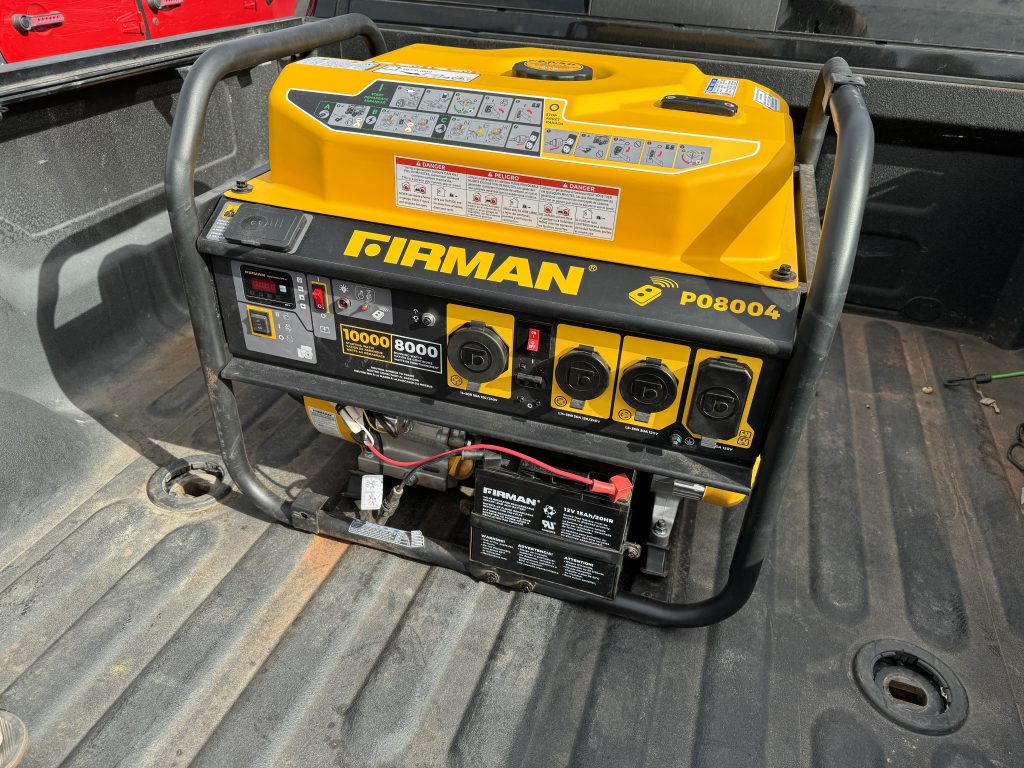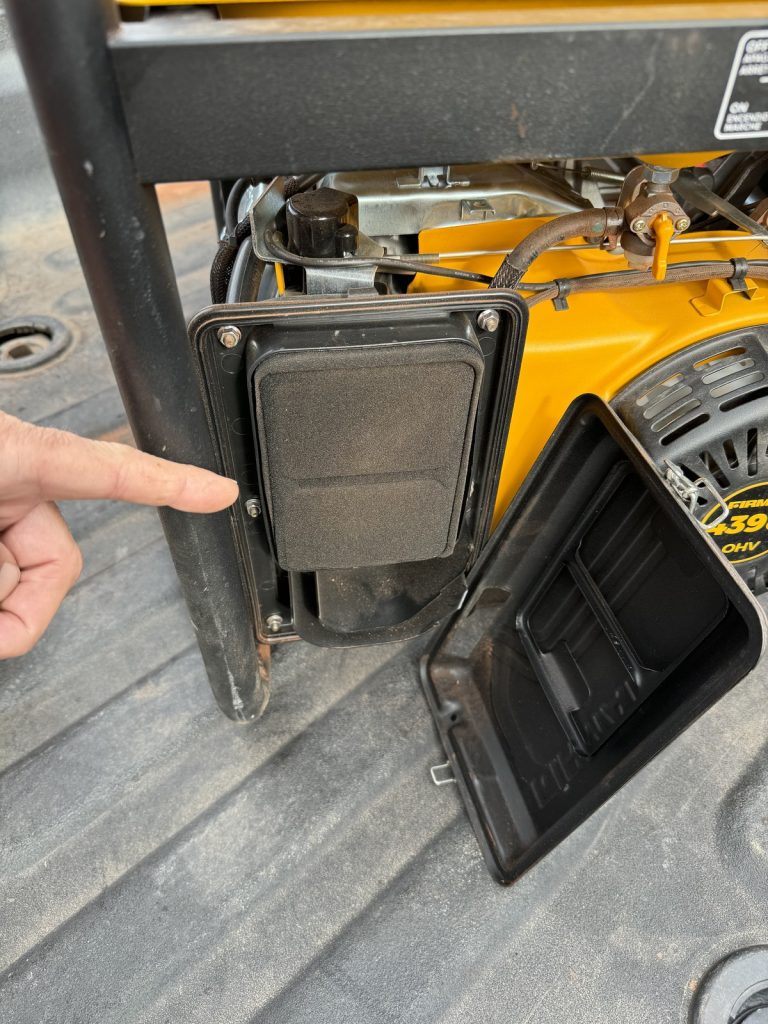Imagine this: You’re camping in the Arizona wilderness in your RV, enjoying the peace and quiet of nature under a star-studded clear January sky. You have a portable electric generator for emergencies. You think you are prepared for anything until one night when your generator suddenly stops working. You are left in the dark and cold, with no way to fix it. What do you do?
Read on; following these simple steps will ensure that your portable electric generator will serve you well for many years and camping trips to come.
When Your Portable Electric Generator Fails
This happened to my friends Sue and Andy, who were dry camping with me and other friends on the Bureau of Land Management (BLM) property west of Quartzsite, Arizona. They had a portable electric generator that they thought was reliable, but it was poorly maintained and faulty.
Luckily, the next morning I could help them with a temporary repair. They learned a valuable lesson that day: portable electric generators need regular maintenance and care to function correctly and safely.
In this article, I will share some tips and guidelines on maintaining your portable electric generator so you can avoid the hassle and frustration of a generator failure.
You will learn what a portable electric generator is, how it works, and the critical maintenance tasks you should perform. You will also learn how to troubleshoot some common problems and the requirements for storage. Following these simple steps will ensure that your portable electric generator will serve you well for many years and camping trips to come.

A Portable Electric Generator
For many RVers like you and I, a Portable Electric Generator for use during a wilderness or off-grid RV camping trip is essential. A Portable Electric Generator is an asset for those cold and dark nights to maintain the electrical comforts of home.
What Is a Portable Electric Generator?
A Portable Electric Generator can produce electricity from different sources, such as gas, diesel, or propane. These generators are used to power other devices that generally rely on electricity from the grid.
This discussion does not apply to solar power.
But When a Portable Electric Generator Breaks down
A Portable Electric Generator that does not start on demand or breaks down when used on a wilderness campsite, can spoil your off-grid camping experience.
How a Portable Electric Generator Works
A Portable Electric Generator usually has two main components: an engine and an alternator.
-
-
- The engine converts the fuel into mechanical energy that spins an alternator.
- The alternator converts the mechanical spinning energy into electrical energy. Typically, a portable electric generator provides 120VAC, and sometimes they also provides 12VDC.
-
This article and the associated case study illustrate the benefits and identify the critical maintenance tasks you should perform.
I Went to Work on The Generator
Suddenly, the peaceful calm of the early afternoon on the BLM land was broken by a couple of engine backfires and a cloud of smoke.
I had been working for a few hours, including a visit to Quartzsite for parts. I emerged through the smoke, looking like a clown; my safety glasses had kept the skin around my eyes clean. My face was blackened with dirty hand marks, but I was smiling.
“The generator is working,” I said, “I have connected your trailer to the generator, and it’s charging your batteries. We will let it run for an hour before we check again.”
I had found the generator poorly maintained. My temporary fix works, but I advised them to have their dealer perform a complete overhaul when they get home.
I then discussed the importance of regular preventive maintenance for portable generators to increase reliability and save money on repair bills.
Generator Preventive Maintenance
-
-
- Tools required. No special tools are required.
- System Checks. Each portable electric generator is different. Always refer to the manufactured manual for maintenance intervals.
- Checking Fluid Levels. This includes checking the fuel, oil, and water (if applicable) levels. Some generators are water-cooled. Check the coolant. Always carry extra oil, fuel, and fuel stabilizer.
- Battery Electrical Connections. Electrical connections should be cleaned regularly with an approved cleaner to ensure smooth operation. Check fuse type and amp rating, carry more than one spare fuse.
-

-
-
- 10 Minute Regular Generator Test Runs every 1 to 2 months. Regularly scheduled test runs will ensure your generator is in working order when needed most and that problems are identified early.**SAFETY TIP** DO NOT TEST OR RUN A GASOLINE GENERATOR INDOORS; THE EXHAUST FUELS CAN KILL
- Take The Time to Test Your Investment. It is typical for a generator to sit for months or years without running.
- Do not leave gas in the generator tank.
-

-
-
- After each trip or when planning to lay up the generator, drain the gas tank into a safe storage container and add a gasoline stabilizer.
- Fuel left in the tank, fuel lines, and carburetor will form a sticky substance, damaging the engine. Adding a stabilizer to the generator tank does not ensure complete mixing. Drain, mix additives, and store fuel in an approved container in a safe location.
- Run the generator until it stops for lack of fuel.
- Annual Inspection of Spark Plug. Remove and visually check the spark plug on gasoline engines. It should be a light gray color, not black. Black implies a carburetor problem. Refer to the owner’s manual. Check cable and connector for signs of electrical arcing or corrosion.
-

-
-
- Control Panel Verification. Note all control panel readings when the Portable Electric Generator is new or has just been serviced. These are your baseline references. Regularly checking the control panel and these readings can help identify potential issues before they become serious.
- Fuel and Air Filters. Changing/cleaning Fuel and Air Filters Regularly. Changing or cleaning fuel and air filters is crucial for maintaining the generator’s efficiency. Refer to the owner’s manual.
-

-
-
- Gas Tank. Gasoline can go off when stored without a stabilizer. Water contamination and fuel deterioration typically show as follows:
- A rough idling engine
- Stalling when under load
- Note: very old gasoline will clog and may permanently damage internal engine components.
- Wiring and Connector Inspection. Inspect and clean wiring and connectors regularly. Dirt, dust, and corrosion can cause generator failure.
-

A Final Word
-
-
- My review shows how neglecting portable electric generator maintenance can lead to severe problems and how to avoid them.
- Regular maintenance of your portable electric generator can extend its lifespan, save money on parts and repairs, and ensure trouble-free operation. You purchased a portable electric generator for comfort when dry camping. These suggestions will help you protect your investment.
- Regular maintenance benefits you by ensuring that the generator will start and run when you need it.
- Do not leave gas in the generator tank.
- Run the generator until it stops for lack of fuel before storage.
-
Act Now
1. It is easy to forget steps and time intervals for routine maintenance. Hang a list of actions and dates inside your RV. Tick off the date when each step was performed.
2. Your feedback and experience would be valuable to other RVers; please send comments to the Explorer RV Club.
Malcolm Callister Experience and Certifications
I obtained engineering training from the Central Electricity Generating Board in England, where I served as a Maintenance and Operations Engineer on oil and nuclear power plants. I hold an HNC certificate in Electrical Engineering. My career in England encompassed roles such as an Oil Refinery Workshop Technologist and Supervisor, an Emergency Service Engineer at Honeywell, and a Maintenance Manager at a steel mill.
My comprehensive maintenance background and experience led to my recruitment by the Canadian Nuclear industry as a Nuclear Safety System Subject Matter Expert. In this role, I assumed a leadership position in troubleshooting and equipment maintenance planning on Nuclear Power plants in Ontario and New Brunswick.
Since 2005, I have been an active RVer, owning two fifth wheels and one travel trailer. I perform all my own RV and home maintenance. This hands-on experience with RVs has further enhanced my understanding of portable generators.
Please note: Malcolm Callister is a professional with an extensive background in Engineering and Maintenance. If you do not feel comfortable performing these tasks, please contact one of your local RV dealers for assistance.




